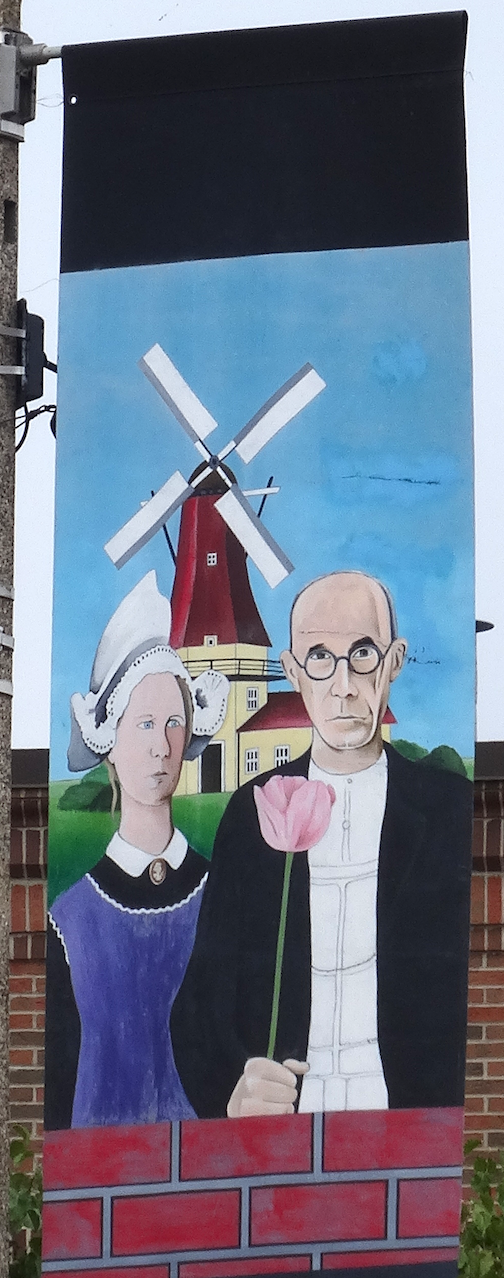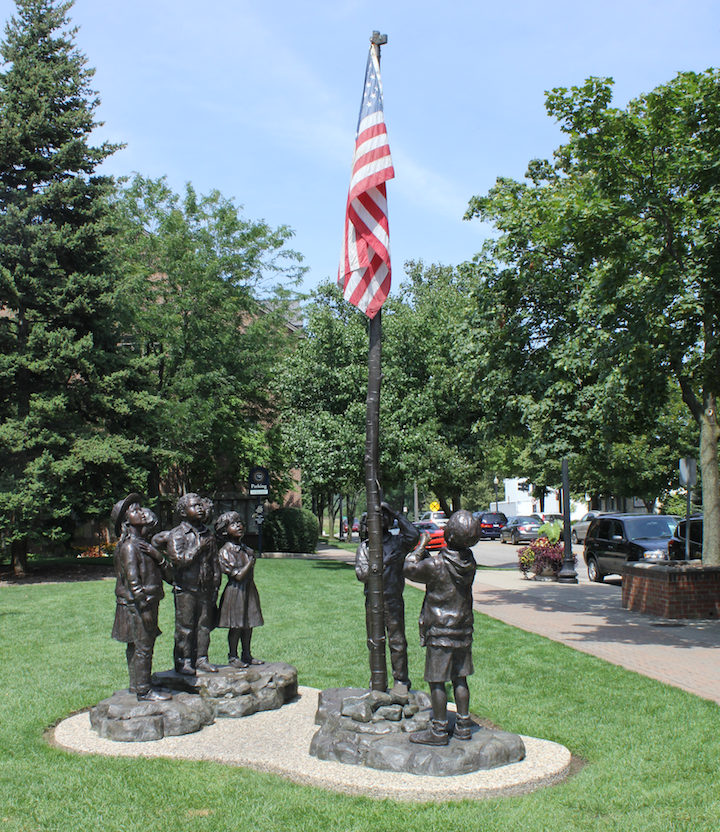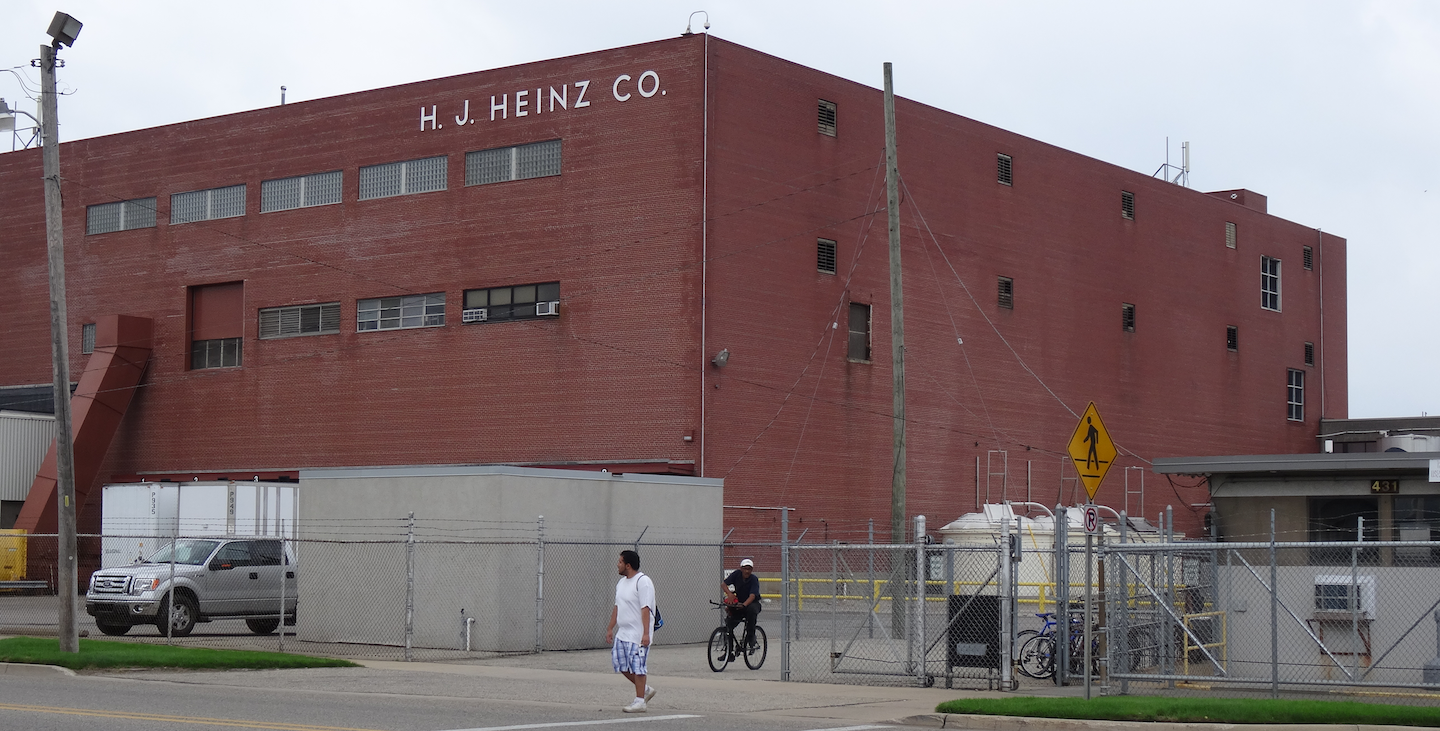
Before I get to the end of this post, I'll explain why the image you see here is not how the people of Holland, Michigan, would like their town to be understood. Yet it's part of a whimsical downtown series of public-art posters in which familiar paintings are given an a la Hollandaise touch. You'll see another below -- the first one obviously after Grant Wood, the second Manet. The fact that a city of some 35,000 people has a downtown commercially and culturally vibrant enough to support this sort of display is part of the story that seems worth figuring out and trying to tell.
This is an early "substance" post in our American Futures series. I think it's useful that my wife and I are beginning this project at the same time that my colleague Ta-Nehisi Coates is in the process of discovering France, and explaining his stages of discovery. In both cases, writers/ observers are wrestling with what is knowable on short exposure, and what takes a very long time to figure out. I realized recently that the professional activity I have done more frequently than anything else is exactly what we are undertaking now: Going some place unfamiliar and asking, What is going on here? I want to say something more about how that process works.

There are first impressions you want to record, because very soon you will stop noticing them. Sometimes they hold up: in my first article after we moved to China seven years ago, I wrote that I had never experienced a society simultaneously so controlled, and so out of control, as China. As the years went on, I realized that most of what I learned was merely an elaboration on that point. Yet other first impressions turn out mainly to be naive.
When you visit new places, you start with a set of questions you'd like to ask -- and then open yourself to the answers people want to give, regardless of the question. The interaction of the planned and the unpredictable, serendipity and design, is the difference between the experience of seeing almost anything -- a city, a country, a factory, a meeting -- and just thinking about it and understanding it at arm's length.
As time goes on, you get some basis for comparison. When you've seen one Chinese factory, you think: This is how factories are in China. When you've seen a hundred, you can say: This is a typical Chinese factory, except ... The opportunity to keep doing this, repeatedly, is what I value about this line of work. As I have often explained, the horrible price you pay is having to do the writing.
When it comes to the Coates family in Paris, this wonderful post by Ta-Nehisi explores a point I remember grappling with and writing about when we were in Japan long ago. As a black man in America, he has always had to "think about" race in a way that I, as a white man, didn't. As the Stephen Colbert character says, "I don't see race." Yet as a native English-speaker in Europe, Ta-Nehisi recognizes that he doesn't have to "think about" the world's dominant language. It is his, by birthright -- and yet he notices the "private" languages with which non-English speakers around him can exchange signals he is missing, much as white Americans are aware of signals among African-Americans that whites miss. And as I wrote in the Atlantic long ago, one benefit to my sons of going to Japanese public school, a "benefit" not fully clear to them at the time, is that it put them, as white American young men, in a situation in which they had to "think about" their race all the time. This is my way of saying that one of Ta-Nehisi Coates's early impressions resonates with my experience outside America over the years.
Let's get back to Holland, and the philosophy we're applying during this journey. Any city -- any family, any person -- could take a lifetime to understand fully. We've been here for a few days, have asked people questions and have listened to what they've volunteered, and will have another day or two of more of the same before we're off to the next stop. We're surer than when we arrived that there are several objectively unusual aspects of the town that deserve both note and explanation -- beyond its identity as a heavily churched area whose public art also includes non-whimsical statements like this:

Among the objective elements that make Holland and unusual, and the questions they raise in turn:
- This town and the immediate area have an extraordinary concentration of manufacturing facilities, of the kind you might not imagine exist in America any more. The "Big Three" of the world's office-furniture industry -- Steelcase, Herman Miller, and Haworth -- are here or in the immediate environs. A number of major auto-industry suppliers still have viable plants, some of which have shifted to other product lines. Korea's LG company has its biggest battery factory outside of Asia (a special story, for another time). A college friend of mine runs a metal/ plastic/paper recycling works that employs well over 500 people. This is not even to mention the world's largest pickle-processing plant, below.
San Francisco has a culture of people who start new web companies; DC, people who start new blogs or interest groups or think tanks. In this part of Western Michigan, it's a culture of people who start companies that make things. This reminds me of Southern China, and as with China it makes me curious about why, and why here.

- The city is small, but its downtown seems to have genuine life, in a way that is puzzling to anyone who has seen most comparable downtowns get hollowed-out and turned into check-cashing/pawn-shop strips as the big-box stores come into town. It can't have survived by accident, and I have been asking about the explanations.
- A number of very rich industrial families still live in or feel connected to this little town. How they rose to wealth is one interesting question; why they stay here is another.
- Holland has Lake Michigan on one side, and the lagoon-like Lake Macatawa on another, and has the attributes of a resort town (see below) -- yes it seems not to have a tourist-dependent economy.

- Holland's identity is -- no surprise! -- traditionally Dutch, and I have seen more Dutch-origin names here than anywhere except Amsterdam. Yet its public schools are "majority-minority," and -- like the rest of the Midwest, we keep discovering -- it is a tremendous magnet for especially Latino immigration. This is the timeless American saga, with new elements here we are learning about.
- There is a college right in the middle of downtown; there are sophisticated European-staffed design operations in a city that seems to project a proud retro-American inland provincialism; it seems big and it seems small. All this too is something we're trying to learn more about.
- And ... New Holland Brewing, right downtown!

This is a "showing our work" introductory note: what we're trying to do, how we're trying to do it, what we're guessing at, the patterns we're looking for. In the next few days more about Holland's factories and why so many have survived; about its shifting demographics and the strains they create and ease; about the surprising civic culture that seems to account for many of its successes; and about the risks and fears we've heard people talk about. This is certainly enough for now -- and also, we hear that the Holland Symphony is giving a free outdoor concert in the park.
